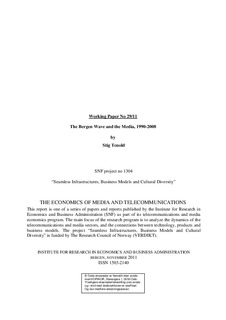| dc.contributor.author | Tenold, Stig | |
| dc.date.accessioned | 2011-12-20T13:10:14Z | |
| dc.date.available | 2011-12-20T13:10:14Z | |
| dc.date.issued | 2011-11 | |
| dc.identifier.issn | 1503-2140 | |
| dc.identifier.uri | http://hdl.handle.net/11250/166660 | |
| dc.description.abstract | Music scenes have frequently been closely related to geographical locations; Merseybeat and Liverpool; Motown, techno and Detroit; and grunge and Seattle. In Norway, the term ‘the Bergen wave’ characterizes periods where specific artists from Bergen have been particularly prominent. The term emerged in the beginning of the 1990s, but resurfaced – linked to a new generation of artists – around ten years later.
This working paper has two main aims. The first is to investigate to what extent a specific phenomenon within music, such as the Bergen wave, is evident through chart and critical success. The data shows that while the second Bergen wave was characterized by both high sales and critical acclaim, the first wave was primarily a media phenomenon, with critical acclaim but limited commercial success. The second aim is to analyze the relationship between the main stakeholders and the scene, in particular the role of media in creating and promoting a local scene. | no_NO |
| dc.language.iso | eng | no_NO |
| dc.publisher | SNF | no_NO |
| dc.relation.ispartofseries | Working paper;2011:29 | |
| dc.title | The Bergen Wave and the Media, 1990-2008 | no_NO |
| dc.type | Working paper | no_NO |
| dc.subject.nsi | VDP::Humanities: 000::Musicology: 110::Music history: 111 | no_NO |
| dc.subject.nsi | VDP::Social science: 200::Economics: 210::Economics: 212 | no_NO |
